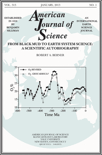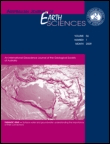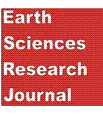
Science China-Earth Sciences
Scope & Guideline
Bridging Global Research and Local Insights in Earth Sciences.
Introduction
Aims and Scopes
- Geological and Geophysical Processes:
The journal focuses on the study of geological formations, tectonic processes, and geophysical phenomena, particularly in the context of the Qinghai-Tibetan Plateau and other significant geological regions. - Climate Change and Environmental Science:
Research addressing the impacts of climate change, including its effects on ecosystems, hydrology, and atmospheric conditions, is a core area of the journal's focus. - Paleoclimatology and Stratigraphy:
The journal contributes to the understanding of Earth's historical climate through studies of sedimentary records, stratigraphy, and paleoenvironments, particularly in relation to significant geological events. - Natural Hazards and Risk Assessment:
There is a significant emphasis on the assessment of natural hazards such as earthquakes, landslides, and floods, along with their impacts on human activities and the environment. - Resource Exploration and Environmental Sustainability:
The journal also addresses the exploration and sustainable management of natural resources, including minerals, water, and energy, with a focus on their environmental impacts. - Technological Advances in Earth Sciences:
Research that incorporates innovative methodologies, including remote sensing, data assimilation, and machine learning, is highlighted to enhance the study of Earth sciences.
Trending and Emerging
- Machine Learning and AI Applications:
There is a growing trend in the application of machine learning and artificial intelligence techniques to analyze geological and environmental data, enhancing predictive modeling and data interpretation. - Climate Change Impacts and Adaptation Strategies:
Research focusing on the impacts of climate change, particularly in relation to water resources, agriculture, and natural hazards, is increasingly prominent as global awareness of climate issues rises. - Interdisciplinary Approaches to Earth Sciences:
Emerging studies are increasingly integrating multiple disciplines, such as geology, ecology, and social sciences, to address complex environmental issues and promote sustainable practices. - Natural Resource Management and Sustainability:
There is an upsurge in research aimed at understanding the sustainable management of natural resources, including minerals and water, in the context of environmental protection and climate resilience. - Paleoclimate Reconstruction Techniques:
Innovative methodologies for reconstructing paleoclimate data from geological records are gaining traction, reflecting a renewed interest in understanding historical climate dynamics. - Geophysical Imaging Techniques:
Advanced geophysical imaging techniques, such as magnetotellurics and seismic tomography, are being increasingly utilized to study subsurface structures and processes, indicating a trend toward high-resolution subsurface analysis.
Declining or Waning
- Traditional Geological Mapping Studies:
There has been a noticeable decrease in papers focused solely on traditional geological mapping techniques, as the field moves toward more integrated and technologically advanced approaches. - Basic Geochemical Characterization:
Research centered on basic geochemical characterization of minerals and rocks has seen a decline, possibly due to the increasing complexity and interdisciplinary nature of modern geochemical studies. - Static Climate Models:
Papers utilizing static or less dynamic climate models are becoming less frequent as the field shifts toward more sophisticated, dynamic modeling approaches that can better simulate climate interactions. - Historical Geology with Limited Application:
Studies focusing solely on historical geological contexts without clear implications for current issues, such as climate change or resource management, are less frequently published. - Conventional Seismology:
There is a waning interest in conventional seismological studies that do not integrate advanced computational techniques or interdisciplinary approaches, as the field evolves to incorporate more complex modeling.
Similar Journals

GEOSCIENCES JOURNAL
Advancing Knowledge in Earth and Planetary Sciences.Welcome to the GEOSCIENCES JOURNAL, a pivotal publication in the fields of Earth and Planetary Sciences and Environmental Science, proudly presented by the Geological Society of Korea. Established in 1997, this journal has become a prominent platform for researchers, professionals, and students, offering a rich collection of peer-reviewed articles that explore a diverse array of geoscientific topics. With an impressive Q2 ranking in both Earth and Planetary Sciences and Environmental Science categories for 2023, it stands as an essential resource in the academic community. Though it operates under a traditional subscription model, GEOSCIENCES JOURNAL remains dedicated to advancing knowledge through rigorous research. Addressed from its headquarters in Seoul, South Korea, the journal aims to foster a deeper understanding of geosciences, encouraging innovation and collaboration in tackling today’s environmental challenges.

AMERICAN JOURNAL OF SCIENCE
Elevating Scientific Discourse in Earth and Planetary SciencesThe American Journal of Science, published by the esteemed Amer Journal Science, stands as a leading platform for groundbreaking research in the field of Earth and Planetary Sciences. With an impressive impact factor and distinguished Scopus rank 34/195 in its category, the journal occupies a prestigious position in the academic community, reflecting its high-quality and influential contributions to scientific knowledge. The journal’s objective is to disseminate original research, comprehensive reviews, and critical discussions that advance our understanding of geological processes and planetary phenomena, supporting scholars and practitioners in their pursuit of knowledge. Despite its traditional publication structure, viewers can explore its rich repository of works dating from 1945 to present, offering a wealth of insights into the dynamic Earth sciences. The journal remains a vital resource for researchers, professionals, and students eager to engage with the latest scientific findings and foster further innovation in the field.

Vietnam Journal of Earth Sciences
Fostering Collaborations for a Greener TomorrowThe Vietnam Journal of Earth Sciences, ISSN 0866-7187, is a premier publication from the Publishing House Science and Technology based in Viet Nam, dedicated to fostering advancements in the field of Earth and Planetary Sciences. Operating under a Q2 ranking in the 2023 category of Earth and Planetary Sciences (miscellaneous) and positioned at Rank #62 out of 195 in its general category on Scopus, this journal serves as a critical platform for researchers, professionals, and students seeking to disseminate and engage with high-quality scientific findings. Despite being part of the non-open access model, the journal is committed to providing compelling content, encompassing a range of topics from geological hazards to environmental sustainability, ensuring its relevance and contribution to both local and international scientific communities. With coverage that spans from 2018 to 2024, the journal is poised to continue its role in addressing pressing Earth science issues and fostering collaborations among scholars in an increasingly interconnected world.

AUSTRALIAN JOURNAL OF EARTH SCIENCES
Exploring the Depths of Earth SciencesAustralian Journal of Earth Sciences, published by Taylor & Francis Ltd, has established itself as a leading journal in the field of Earth and Planetary Sciences since its inception in 1984. With an impactful reach reflected in its ranking as Q2 in the Earth and Planetary Sciences category, the journal contributes significantly to the advancement of knowledge through rigorous peer-reviewed research. While it is not Open Access, the journal ensures broad accessibility through institutional subscriptions and various academic platforms. With a commitment to covering diverse topics within the Earth sciences, including geosciences, geology, and environmental studies, the Australian Journal of Earth Sciences is an essential resource for researchers, professionals, and students seeking to deepen their understanding of the dynamic processes that shape our planet. Engaging with the journal means being part of a vibrant community that aspires to push the boundaries of scientific inquiry and innovation in Earth sciences.

Frontiers of Earth Science
Elevating Earth Science Research to New HeightsFrontiers of Earth Science is a prominent academic journal in the field of Earth and Planetary Sciences, published by Springer. With an ISSN of 2095-0195 and an E-ISSN of 2095-0209, this journal serves as a significant platform for researchers and professionals to disseminate their findings from 2007 to 2024. It is recognized for its impactful contributions within the category of Earth and Planetary Sciences, boasting a respected Q2 ranking in 2023. With a Scopus ranking of 64 out of 195, placing it in the 67th percentile, Frontiers of Earth Science continues to drive academic dialogue and innovation. The journal is dedicated to exploring a diverse range of topics, including geology, meteorology, and environmental science, and amplifying the understanding of Earth systems through rigorous research. Located in New York, USA, this journal embraces an Open Access model, ensuring that groundbreaking research is readily available to the global scientific community, thereby enhancing its accessibility and impact.

Geofizicheskiy Zhurnal-Geophysical Journal
Enhancing Understanding Through Rigorous ResearchGeofizicheskiy Zhurnal-Geophysical Journal, published by the esteemed S I Subbotin Institute of Geophysics, National Academy of Sciences of Ukraine, stands as a vital resource for professionals and researchers in the field of geophysics. With an ISSN of 0203-3100 and an E-ISSN of 2524-1052, this journal is recognized for its rigorous peer-reviewed articles that delve into various aspects of geophysical research, including seismic studies, geodynamics, and Earth surface processes. Although currently not under an open access model, the journal maintains a commitment to disseminating high-quality research, thereby enriching the global geophysical community. The publication aims to foster collaboration and knowledge transfer among scientists and engineers while addressing complex geophysical challenges in a rapidly evolving landscape. By engaging with cutting-edge research, readers can expect to uncover insights that advance both theoretical understanding and practical applications in geophysical science.

Geodynamics
Illuminating the Dynamics of Our EarthGeodynamics is an emerging scholarly journal published by LVIV POLYTECHNIC NATIONAL UNIVERSITY, dedicated to advancing knowledge in the fields of Earth and Planetary Sciences, with a particular emphasis on Geophysics, Geology, and related specialties. Featuring both ISSN 1992-142X and E-ISSN 2519-2663, this journal aims to publish high-quality research that addresses critical challenges in geodynamic processes and their implications on our planet's systems. Despite its nascent status, having converged years from 2023 to 2024, Geodynamics is poised to attract attention in the academic community, especially as evidenced by its rankings in Scopus, which position it prominently within the discipline. The journal's commitment to open access ensures that cutting-edge research is readily available to the global scientific community, fostering collaboration and innovation. Researchers, professionals, and students will find Geodynamics an essential resource for the latest findings and discussions in geodynamics and related fields, making it an invaluable addition to the landscape of environmental science journals.

JOURNAL OF THE GEOLOGICAL SOCIETY OF INDIA
Fostering scholarly dialogue in Earth and Planetary Sciences.JOURNAL OF THE GEOLOGICAL SOCIETY OF INDIA, published by Springer India, serves as a pivotal platform for researchers and practitioners in the field of geology. Established in 1979, this journal has been instrumental in advancing geological research throughout India, showcasing both regional studies and cutting-edge global research. With its Category Quartile ranking of Q3 in the geology category for 2023, and a significant Scopus rank of 171 among 321 journals in Earth and Planetary Sciences, it remains a respected source of scholarly activity. The journal is dedicated to the dissemination of original research articles, reviews, and case studies that encapsulate the dynamic scope of geological science, thus contributing to the understanding of geological phenomena. Although currently not offering open access, the journal maintains a commitment to high-quality scholarship and aims to engage a diverse readership, enhancing the knowledge and practice of geology across various disciplines.

Geosciences
Fostering Innovation in Geosciences Research.Geosciences is a prestigious open-access journal published by MDPI, dedicated to advancing research in the field of Earth and Planetary Sciences. Since its inception in 2011, this journal has fostered a collaborative environment for the dissemination of innovative ideas and findings, contributing significantly to the academic community's understanding of complex geological processes. The journal has achieved a commendable 2023 ranking in the second quartile (Q2) within its category, highlighting its impact and relevance in the field, with a Scopus rank of #41 out of 195 journals, placing it in the 79th percentile. With an aim to span a broad range of topics from environmental geology to planetary exploration, Geosciences is pivotal for researchers, professionals, and students looking for an accessible platform to share their work and stay informed of the latest developments. As a fully open-access journal, it ensures that high-quality research is freely available, fostering greater dissemination of knowledge across the globe.

Earth Sciences Research Journal
Unveiling Insights into Earth’s MysteriesThe Earth Sciences Research Journal, published by the UNIV NACIONAL DE COLOMBIA, serves as a pivotal platform for the dissemination of knowledge in the diverse field of Earth and Planetary Sciences since its inception. With an ISSN of 1794-6190 and an E-ISSN of 2339-3459, this Open Access journal has been committed to providing unrestricted access to high-quality research since 2004. Located in Bogotá, Colombia, it has gained recognition within the academic community, achieving a Q3 quartile ranking in Earth and Planetary Sciences and notable Scopus rankings, which further underscores its relevance and reach. Its scope encompasses varied research topics, making it an essential resource for researchers, professionals, and students alike, seeking to contribute to or stay informed on the latest developments in the Earth sciences up to the year 2024. The journal not only anticipates cutting-edge research but also emphasizes collaborative dialogues among global experts, driving forward the conversation on critical issues facing our planet.